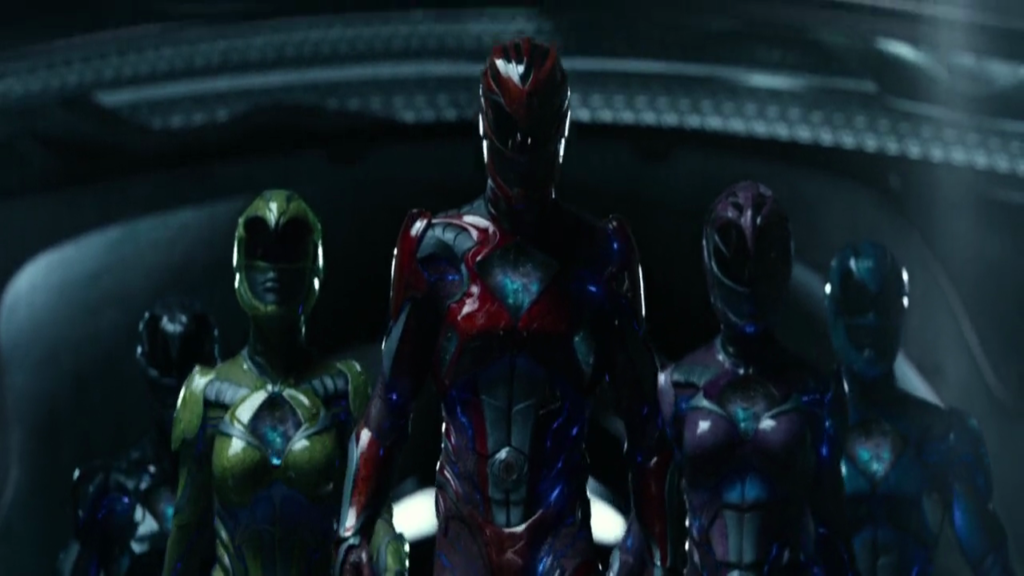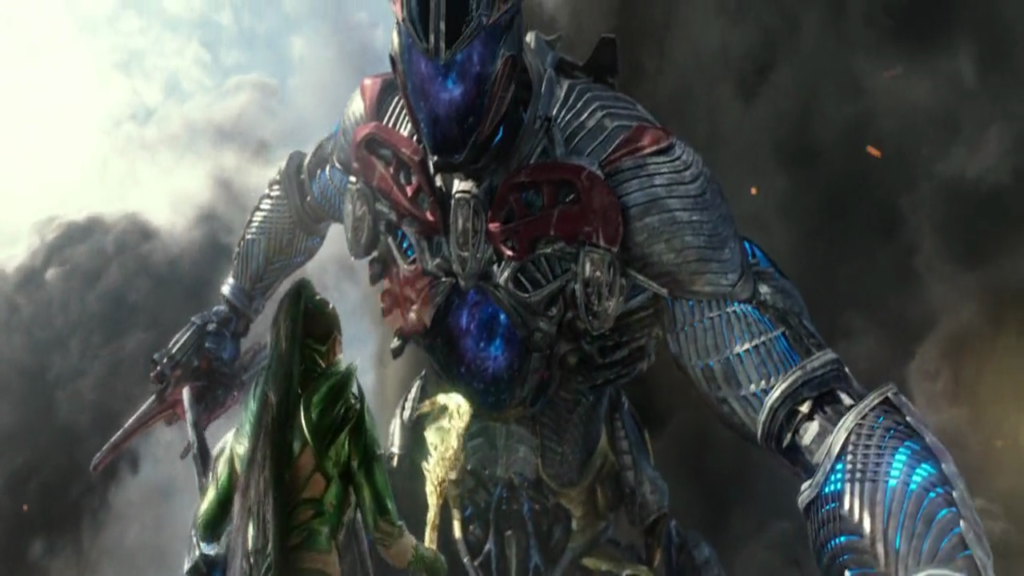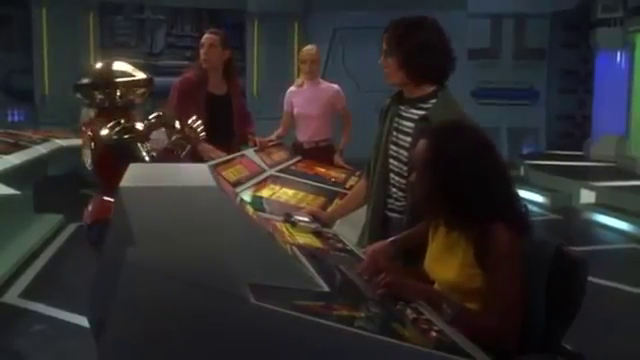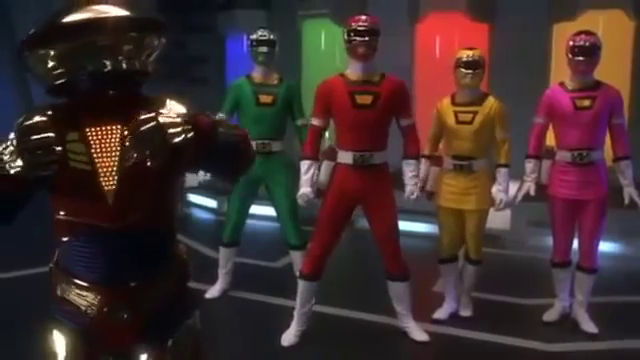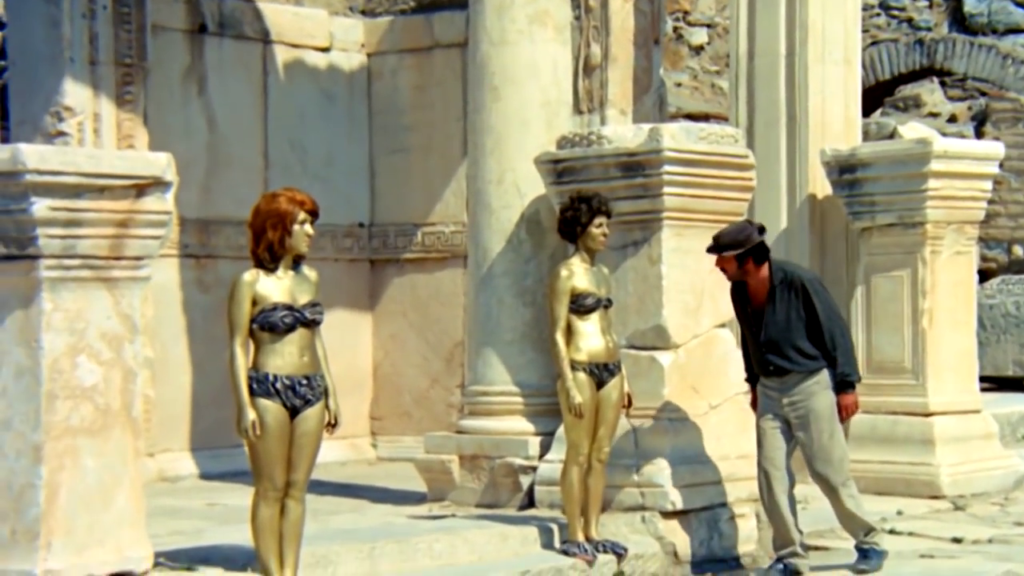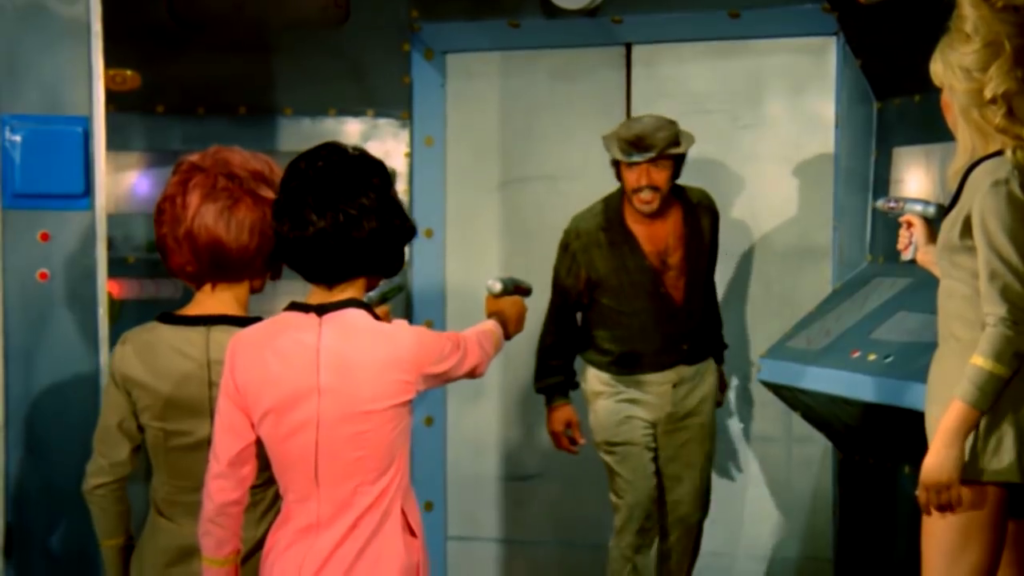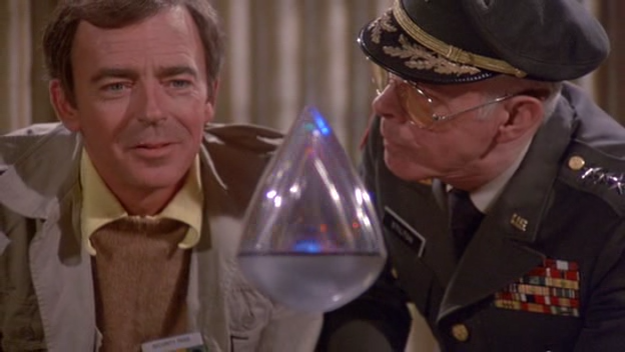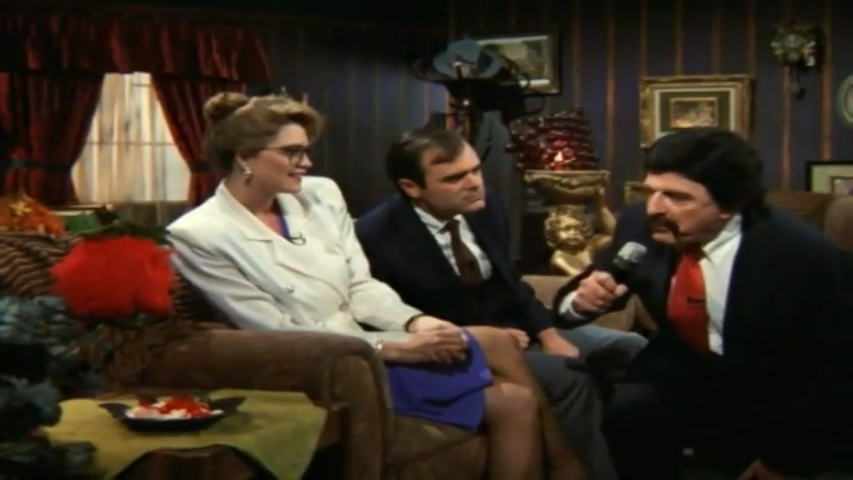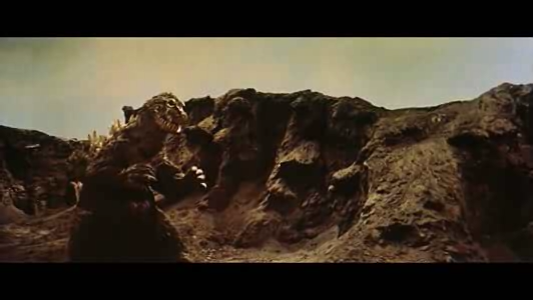-
#347 – Power Rangers (2017)
Power Rangers (2017)
Film review #347
Director: David Israelite
SYNOPSIS: 65 million years ago, Rita Repulsa attempted to take the powerful Zeo crystal from Earth and destroy all life on the planet. She was sealed away by Zordon, leader of the Power Rangers, who are the guardians of life. In the present day, Rita is released from her prison, and the powers of the the rangers find their way into five new teenagers. They learn that Rita will destroy their hometown of Angel Grove in search of the Zeo crystal, and must find a way to overcome their personal troubles and learn to work as a team and unlock the full might of the Power Rangers.
THOUGHTS/ANALYSIS: Power Rangers is a 2017 sci-fi film that is a re-imagining or reboot of the Mighty Morphin Power Rangers franchise. The film starts off 65 million years ago, with the Power Rangers defeated and their leader, Zordon, deciding to seal away their powers along with Rita Repulsa to stop her getting her hands on the Zeo crystal and destroying all life on Earth. In the present day, we see high school student Jason and his friends pulling a prank that goes wrong, leading to Jason crashing his car (also, the opening joke with the cow just feels completely out of place). Cut to a few weeks later and Jason is now tagged after being arrested, his car is ruined, and his dreams of getting a scholarship are over. He starts going to detention where he meets Billy and Kimberley, who are also stuck there. After Jason stops a bully from picking on Billy, he offers to hack his tag so he can stay out after curfew. Billy then makes him an offer for him to drive him to a local mine in return for using his van, to which Jason agrees. They arrive at the mine and Jason leaves Billy to go and do whatever he came to do. Jason also runs into Kimberley and some other teenagers who are hanging around the mine, as Billy uses some explosives to blast some strange rocks out of a wall. Each of them takes one of the stones and escape the mine with security in pursuit. The opening of the film really focuses on exploring the different origins and personalities of the five teenagers, and how they start off from not knowing each other to developing a common bond. It’s a little slow to start off with, and you don’t see much of the typical Power Rangers action, but there’s enough to keep things interesting, with each of the characters making a unique mark on the film. There’s also a decent amount of effort taken to provide more of a backstory and make it more clear, such as the Zords forms being taken from the dominant lifeforms on the planet 65 million years ago, and Zordon being the previous red ranger and their leader, with Rita also being a power ranger that betrayed them.
The original premise of the Power Rangers was that they were five “teenagers with attitude”, but given that it was a children’s show, that “attitude” was rather muted and ineffectual. This film changes that, by allowing the teens to act like teens, and to have the sorts of issues and difficulties that teenagers have. Each of them has a unique problem in their life, and everyone can probably relate to at least one of them. Their characters are based on the original series, but there’s enough difference to make it feel fresh and different. When the group finds Zordon and Alpha 5, they learn they must learn to work together to unlock their full potential as Power Rangers, and try to figure out what they are missing. In the camp fire scene, which is probably one of the highlights of the film, they all share their secrets and despite they are all messed up in their own individual ways, they can still support each other and work together to protect what is important to them. Again, this is something you don’t expect from a film based off a kid’s TV series: the film takes nothing and turns into something, and that is an accomplishment. Perhaps the direction it goes in turning it into a teen drama would not appeal to some people, but it had to do something different to hold the film together and justify its existence. The rest of the characters, such as Zordon, Alpha 5 and Rita Repulsa all have a familiar look and feel to them, but also are different enough to offer a fresh take on their characters, with Zordon previously being the red ranger and getting his team killed, he displays regret, but also has his own motives, which makes him a much more dynamic character rather than just the benevolent overlord of the original. Alpha 5, who was arguably the most annoying character in the series, is toned down, and feels more like an exasperated administrator rather than the squealing worrier he was. Rita’s character too is toned down, and is a lot more menacing, while still having enough of the dramatic deliveries that made her so iconic. Sadly, the characters of Bulk and Skull, the school bullies aren’t present in this film, probably because they were so slapstick and silly that it would have been out of place, and bullies really don’t go around wearing leather jackets and pulling pranks anymore (although the bully that goes after Billy does wear a leather jacket, probably as an homage to the two).
Eventually, the power rangers are able to morph into their iconic suits, and it certainly takes a long time to get to it. As a consequence, there isn’t much time to showcase them fighting, but at this point you’ll be too invested in the characters to be concerned about it. It is a shame we don’t get to see more of the suits and Zords fighting, but one of the mistakes the previous films did was prolonging the fights to the point that made them boring to sit through, and drew attention to the fact that there was little substance underneath it all. This is quite a long film, coming in at just over two hours, and overall I think it does justify that screen-time through the way it develops its characters and backstory. The build-up to the final battle and the fight itself goes through all the stages you’d expect, so there’s no big surprises, but it keeps to the power rangers formula and gives you what you would want to see. In particular, the scene with the Zords rushing into battle and the original TV theme accompanying it exactly what you would want to see.
So who is this film aimed at? The focus on teenage drama obviously points to an older audience than the TV series, and that is further supported by the language and some of the jokes being a little more adult-oriented. For people who grew up watching the TV series as a kid this would be a decent nostalgia trip, while also being fairly entertaining. Kids who are also on the cusp of getting too old for the TV series might find this film would appeal to them, but I’m not sure if someone who had never seen anything power rangers related before would appreciate it as much. Again, the characters are very well developed, and stand on their own so you can invest in their stories no matter how much you know about the power rangers, but fans of the franchise will definitely appreciate some of the details thrown in. One such detail is how Rita seems to use a green power stone, which presumably means she was once the green ranger, a character which was a big part of the original series as it went on, and the mid-credits sequence hints that Tommy Oliver, the green ranger will show up in a sequel. I certainly hope that a sequel would get made: there’s a lot of investment in setting up these characters, and I would be interested in where they could be taken. The issue is Power Rangers is being released into the cinematic medium where superhero films are prevalent and all-consuming, and there’s really no room for something like the power rangers anymore, and so is going to struggle to offer anything exceptional in the genre.
Overall, I enjoyed Power Rangers more than I thought I would. I’m not a huge fan of the franchise, but I do remember watching the original series as a kid, and there’s enough nostalgia in here to make things familiar and also to overlook some of the nonsensical story elements in keeping with it. Giving the main characters a lot more depth and their own individual problems and dilemmas is the film’s main strong point, and creates some surprisingly emotional moments. I wouldn’t say they were groundbreaking, but they were very good. Even though it takes a large portion of the film to get to the power rangers morphing, the film fills its runtime with plenty of drama and story that means it’s never really boring. Some of the jokes are a bit out-of-place or just fall flat, and the effects are not overly special (although fairly decent), but I think the film overall retains enough entertainment, fun and drama to make it worthwhile to watch. It’s never going to compare to the vast library of superhero films it has to compete with nowadays, but it’s a fun nostalgia trip and one that gives the source material much more of an edge than one might expect.
-
#346 – Turbo: A Power Rangers Movie (1997)
Turbo: A Power Rangers Movie (1997)
Film review #346
Directors: David Winning, Shuki Levy
SYNOPSIS: The evil space pirate Divatox is planning to capture the wizard Lerigot in order to use his golden key to release and marry Maligore, whose powers she believes will make her unstoppable. Lerigot escapes to earth to enlist the help of Zordon, but ends up in Africa. Zordon sends Tommy and Kat to find Lerigot before Divatox, but she has kidnapped Lerigot’s family, and he surrenders to her. Zordon gives the power rangers new powers in order to follow Divatox through the nemesis triangle to the island where Maligore is sealed, and to stop her before it is too late…
THOUGHTS/ANALYSIS: Turbo: A Power Rangers Movie is a 1997 film that is a sequel to the 1995 film and a precursor to the Power Rangers Turbo TV series. The film opens with scrolling text that is very reminiscent of Star Wars, which describes how the wizard Lerigot possesses a golden key which is able to unseal the monster Maligore, whose evil powers would ravage the galaxy. The space pirate Divatox plans to release Maligore and marry him so their combined powers would let her plunder the galaxy. Meanwhile in Angel Grove, the male power rangers are entering a kickboxing tournament in order to win the prize money to save a local youth shelter from closing. One of the children who uses the shelter, Justin, comes to see them training just as Rocky, one of the power rangers, has an accident and hurts his back. The rest of the team go to visit him in the hospital, when Zordon calls them back to find Lerigot, who has arrived on Earth. Justin also overhears their conversation and finds out that they are the power rangers. Two of the rangers, Tommy and Kat, are teleported to Africa to find Lerigot before he is weakened too much by the sun’s rays, which are harmful to him. The plot of the film feels more like a fantasy than a sci-fi, with all this talk of wizards, magic, and fantasy-sounding names and locations. One of the problems I highlighted in my review of the previous film is that it didn’t really expand on the Power Rangers experience or offer anything more than a longer episode of the TV series, and thus struggled with filling the film with content. Turbo seems to have gone the other way: it fills the film with all these different concepts, settings and characters so that there is a new experience for the viewer, but it does so much of it that it stops feeling like a Power Rangers film, and the things you want to see are relegated to short and scattered scenes. In fact, we don’t even see the power rangers in their suits until nearly half way through, making the opening really feel like a slow crawl before anything of significance or what you would come to see starts happening on screen.
The Power Rangers themselves are the same ones from the TV series at that point in time, and aren’t particularly developed as individual characters. two of the original rangers, Jason and Kimberley, also make an appearance, as well as the ever-present Bulk and Skull, and so if you’ve followed the series at any point, you’ll recognise these characters fairly easily. The performances, while not amazing, aren’t too bad, and convey a decent amount of emotion and expression; and you don’t need too much more in a film aimed at children. Divatox and her minions are also full of energy, and give off that evil vibe quite well, alongside a little incompetence that makes them not too threatening or scary. There’s also a cool little cameo featuring original villains Rita Repulsa and Lord Zedd, which will no doubt make fans smile.
One of the big issues of this film is that the kid Justin ends up being the blue ranger, and accompanying the rest of the group to stop Divatox. I can’t fault the kids acting, but everything about the character makes no sense and ruins the image of the Power Rangers: the description of them being “teenagers with attitude” just doesn’t work when one of them is a kid, and when the Power Rangers do something cool, he still just acts like a kid, which takes some energy out of the scenes. No explanation is given of why he suddenly becomes the blue ranger; he literally just shows up and says “I’m the blue ranger now”. I think it’s implied that because he worked out that Tommy and the rest were Power Rangers, then he would have to join them, but it’s also established that Power Rangers are chosen because of their heroic qualities or attitudes, and it’s not really mentioned or established which of these qualities Justin has. I get that his character is meant to be one that kids can relate to, and gives them the impression that they could be a Power Ranger too, especially given that he is a troubled kid who is sad and outcast and has issues with his Dad, and can still be a Power Ranger (his background isn’t explored in any huge detail), but this is one of these storytelling devices that I would have hated as a kid, as it broke with what made the Power Rangers who they were: that they were special, and their heroic qualities meant they could do great things, and become Power Rangers. If any kid could do it, then that inspiring sense of justice and heroism just gets diluted and makes it less special. That’s how I would have seen it as a kid anyway. There’s also the issue of Justin growing about two foot taller when he morphs into the blue ranger, which is never acknowledged, referenced or explained, and just breaks a sense of immersion because it raises so many questions. The Power Rangers series uses footage from the Super Sentai TV series in Japan for the segments in costume and the robot zords, with the American actors providing the voiceover, and since in the original show the blue ranger wasn’t a little kid, the Power Rangers series just avoids referencing it.
The Power Rangers travel on board a “Ghost Galleon”, which looks like an old wooden sailing ship, in order to pass through the inter-dimensional “nemesis triangle” to the island where Maligore is imprisoned. Again, there’s a decent amount of content in the story, but the fantasy tone doesn’t really fit with the Power Rangers theme, which is more science-fiction. Eventually, near the end of the film, it gets back to the traditional Power Rangers formula of martial arts action, then giant robot vs monster action, but by that point I just felt exhausted by the long-winded way in which it got there that it was difficult to care anymore. The robots or Zords that the rangers pilot this time around are different types of vehicles. One of the big criticisms of the previous film I had was that the Zords were rendered in CGI, and looked pretty bad, as well as looking a lot different than the TV series, which used models and actors in costumes. Turbo instead keeps things consistent, and uses the model and costume footage from the TV series, as well as creating new models for the Zords, which are all vehicles of some form. This consistency is very welcome, and while the cars do look like they’ve just been made by recolouring some original vehicles with matte paint and sticking a few bits on top, they still fit in with the rest of the effects. The effects on the whole are okay: nothing special, but again it keeps them consistent with the feel of the film and series, which are never high budget extravaganzas. The film ends as you would expect with the Rangers Zords combining to defeat a giant Maligore, and saving the world as always, and it does it in exactly the way you would expect, with the extended transformation sequence, the theme music pumping in the background, and seeing both of them show off their moves. It definitely feels like a Power Rangers movie at the end. Oh yeah and they also win that kickboxing tournament that was mentioned at the start of the film, just in case you were wondering even though it was not mentioned at any other point.
Overall, Turbo: A Power Rangers Movie seems to take the contrary approach than its predecessor, by creating a stronger narrative and quest that gives the Power Rangers purpose and motivation. However, this often has a detriment effect, as all of the extra characters, locations and plot devices can distract from what you want to see in a Power Rangers film. The previous film added as little as possible and suffered for it as well, and it seems Turbo just jumped to the other extreme without finding the middle-ground. However, on the whole it does keep itself in line with the franchise, and delivers everything you would expect it to, along with familiar use of effects, music and styles that make it feel like a Power Rangers movie. The characters, while still underdeveloped, turn in a decent performance; even the kid Justin does a good job, in spite of finding his character unpalatable and an overall distraction. Some throwbacks to older characters and the typical fight scenes make it a good watch for Power Rangers fans, and even though it doesn’t offer anything new or exciting, underneath all the superfluous fantasy stuff there seems to be a good understanding of what makes Power Rangers work, and how to pull it off. There won’t be much substance in here for non-Power Rangers fans, and it’s not amazing for a standalone film, but for the fans there’s plenty of what fans would want.
Oh, and I now have the “Power Rangers Turbo” theme stuck in my head. Forever probably.
-
#345 – Mighty Morphin Powers Rangers: The Movie (1995)
Mighty Morphin Power Rangers: The Movie (1995)
Film review #345
SYNOPSIS: The power rangers, a group of teenagers who defend the city of Angel Grove from alien threats face their biggest challenge yet as a construction work accidentally uncovers a strange device. On their moon base, Rita Repulsa and Lord Zedd recognise the device as the capsule within which Ivan Ooze is sealed; an alien menace that ruled the Earth over 6000 years ago. Lord Zedd frees him and tells him to go kill Zordon, the power rangers mentor. Ivan leaves Zordon close to death and the power rangers without their powers, and so they must travel to a far-off planet to find a great power that can save Zordon’s life and give them back their powers to defeat Ooze once and for all.
THOUGHTS/ANALYSIS: Mighty Morphin Power Rangers: The Movie is a 1995 film that is a continuation of the TV series of the same name. It should be noted that the franchise was absolutely huge in the early-mid 90′s, and so a movie was almost inevitable. The series had lost a bit of steam by the time the movie came out, but it was still fairly popular. The film opens with the team doing a skydive, along with Angel Grove punks Bulk and Skull, the comic relief characters from the TV series. Next, the team go do some roller skating…because that’s what teenagers do I guess? The Power Rangers were always portrayed as “teenagers with attitude”, so doing these sorts of things goes some way to making them look cool and hip or whatever the mid-late 90′s term was (I was never any of those things, so forgive me if I can’t remember). Either way, you’re not really going to watch a Power Rangers film to watch some mediocre roller skating, and the film certainly doesn’t open very strong. Nearby, a construction site unearths a strange capsule from underground. Villains Rita Repulsa and Lord Zedd are watching on from their secret base on the moon, and Zedd remarks that the capsule contains Ivan Ooze, a powerful being that ruled the Earth six thousand years ago, before he was stopped by Zordon and a group of chosen teenagers. Zedd and Rita free Ooze from his containment, telling him to go and destroy his old enemy Zordon, which he happily does (he doesn’t kill Zordon though,for some reason), leaving the Power Rangers without their powers.
The story revolves around the Power Rangers having to go to a far-off planet to obtain “the great power” that can save Zordon’s life, and give them new powers. The structure of the story feels very much like an episode of the TV series, with a new monster arriving to terrorise Angel Grove, and the rangers fighting them on foot, then fighting them in their Zords, then combining the Zords to defeat them. The film offers nothing new to that structure, or provides any fresh ideas to expand the idea of the Power Rangers. It seriously feels like nobody had any idea what to do with the story outside of their comfort zone so they padded it out with the Rangers losing their powers for a good chunk of the film, and also having this subplot with this random kid and his Dad that really serves no purpose. One essential component of the TV series is that the scenes with the Power Rangers in their suits and the Zords are taken directly from the Japanese TV Super Sentai Zyuranger, while the rest of the episodes are made specially for the Power Rangers series. This film is the first time that there is no footage taken from Super Sentai, and everything is originally written and directed. You may think that this gives the film a chance to try something more ambitious, but as mentioned the film seriously struggles without that original footage to coalesce around, and simply tries to copy it to fill that void. The TV series worked because even though it was basically the same thing every week, it gave kids what they wanted in short bursts, with fight scenes that were delivered with a decent pacing that filled its slot nicely. In this film, the decision seems to have been taken to just stretch out those fight scenes, giving more of what kids want: but this was a very bad move, as the fight scenes seem to go on for far too long, and those short, sharp bursts of action become dragged out and you realise they’re actually pretty empty. The same goes for the one-liners that the Rangers deliver, which work once or twice a scene, but when they’re constantly delivering these multiple times a scene, they cease to have any impact, and draw attention to the lack of variety in the story. At some points the Rangers are on screen just doing constant backflips all over the place and nothing is happening, and the film just feels hopelessly lost.
All of the main characters from the TV series reprise their roles in this film, which at least preserves the continuity. Some of the Power Rangers changed throughout the series, and the cast is correct at the point of the series this film was released. The Power Rangers themselves, despite being described as “teenagers with attitude”, are all equally dull, with no real personality or chemistry between them. Tommy, as the leader of the group, makes himself stand out a little, but that’s about it (maybe because the majority of the overall story arcs in the TV series revolved around his character once he was introduced). In contrast, I find the villains are much more entertaining to watch, and even though they are all rather incompetent, have a good chemistry between them. Bulk and Skull, the punk bullies, are very cartoon-like in their mannerisms and actions, and I’ve always found them to be strong characters, even if they don’t do anything too special. Rita Repulsa and Lord Zedd also have a good chemistry, and manage to flirt the line between being comedic and seriously menacing depending on the scenes. The fact they are played so over the top also makes them enjoyable to watch. It’s a shame that Ivan Ooze imprisons them and locks the out of the majority of the film, as it could have done with more of their energy. Ooze himself is a rather forgettable villain: he has his menacing moments, but this is undermined by some rather cheesy lines (”smells like…teenagers”) really lessen his impact. Rita and Zedd could manage both in tandem, but Ooze just doesn’t have that same appeal.
One of the major detriments of the film is that it uses CGI to render the Zords, instead of the models or physical costumes used in the TV series, and it has not aged well at all. Since the TV series used previously made footage, the show didn’t have to produce new footage for the Zord fights at all, and so for the film, which as mentioned used no previous footage, this is the first time these scenes would have had to be built from scratch, and the fight scenes scripted and directed by the writes and producers themselves. Models and physical costumes age significantly better than CGI, and I wonder if the effects used to render the Zords were already out of date when the film came out. The fight scene in the city with the Zords is also rather dark, which obscures a lot of the Zord’s detail so you can’t really get a good idea of what they look like: this might have deliberate because the CGI might have looked even worse in a brighter setting. Overall, the film doesn’t really feel like much more than a cash-grab or an excuse to sell toys. I think what was more appealing about the physical costumes/models as well is that they look more like action figures, and would definitely spark children’s imaginations more than CGI creations (and would probably sell more toys). The film feels like an extended episode of the TV series, but seems to have no idea how to fill in the longer runtime, and so just pads out what they already do, which waters down its impact. The film doesn’t add anything to the franchise, nor does it benefit from a bigger budget or production. Maybe kids at the time would have enjoyed some more Power Rangers action (It is one of the few films I went to see at the cinema as a kid, and I remember having a lukewarm response to it), but a kid nowadays would not be able to get past that awful CGI. The soundtrack is full of mediocre songs that are plucked right from the mainstream of the time, but the worst part is they don’t use the TV theme song, which is one of the most recognisable themes and is really quite good and full of energy. They only use a snippet of it in a fight scene early on, and I think that was a huge mistake not taking advantage of one of the series most iconic aspects. If you were into the Power Rangers hype it kept that hype going, but outside of that it really is not a good film, and I think does some damage to the franchise by undermining the best parts of it, such as making the fight scenes too long, sidelining the iconic villains, ditching the iconic physical models/costumes etc. If you were a kid that was caught up in the original Power Rangers hype, then I would suggest watching the TV series instead of the film: it offers very little as part of the franchise or as a film in it’s own right.
-
#344 – On the Beach (1959)
On the Beach (1959)
Film review #344
SYNOPSIS: After a nuclear war renders the northern hemisphere uninhabitable, the U.S. submarine USS Sawfish docks in Australia, where the last of the world’s population have been fleeing. Dwight Towers, the Captain of the submarine, is summoned by Australian naval command to take the submarine back to North America to test a theory that the radiation may have subsided. Peter Holmes, a young officer in the Australian navy, is to join Towers on board, and invites him back to his home to spend time with his family before they head out. The cast eventually have to come to terms with the end of the world in their own ways, as the radiation slowly makes its way southwards…
THOUGHTS/ANALYSIS: On the Beach is a 1959 film about the end of the world. I have previously reviewed the 2000 TV miniseries that is a remake of the film, so I will do some small comparisons between the two, but focus on this version. The film opens with Captain Dwight Towers of the U.S. submarine USS Sawfish docking at an Australian port, in light of the Northern hemisphere being uninhabitable due to the radiation from a nuclear war. The Australian navy command has a new mission for Towers: to return to the northern hemisphere to investigate an incomprehensible more code signal which seems to be being sent from San Francisco, which should be uninhabitable. Navy officer Peter Holmes ia assigned to Towers’ submarine, and he invites Towers to his home to spend time with his family before they head out. The film focuses heavily on the relationship between the characters, and makes the film more of a drama than a post-apocalypse film.
The world that the film envisions five years in the future (set in 1964 from the 1959 production date) is a society that seemingly has carried on like very little has changed, and order still seems to be maintained, unlike the 2000 film, where society has all but collapsed. There’s some effects of the war, such as people using horses in place of cars since there’s no oil, but other than that everyone still seems to be going about their daily businesses, eiether through ignoring the inevitable, or having no idea what to do about it. This is also expressed through the main characters, as each one has a different attitude to the state of the world, such as Peter’s realism, and his wife Mary’s reluctance to talk about or hear anything about how they are all going to die. Dwight’s sheer reluctance to accept that his family was killed in the war and that they will simply be at home when he returns is very well delivered, and the complications it brings up with Moira’s (Mary’s older sister) attempts to get closer to him means that her usual tricks to seduce men, which she has no moral quabble about, make her hesitate with regards to a man who does not actually have a family, but believes he does. Another strong moment is when Peter talks with his wife about the suicide pills that the government will be offering, as he sees it as the only way to avoid a painful death for her and their daughter, and Mary finally has to confront the uncomfortable truth.
Towers and Holmes set sail to San Francisco to investigate the mysterious signal, and thereby shifting the focus of the film from the human drama to the mystery of the signal and the exploration of hope. This puts a number of the film’s threads on hold, and changes the pace a little. The film gets a bit muddled in the middle, and moving the film away from those relationships it has been building up means the viewer has to shift their focus as well. It has it’s moments, but it doesn’t offer as much drama as the opening. This is a long film as well, going for over two hours, and the scenes are very dialogue-intensive and often lacking musical accompaniment. I felt that the film needed to produce more dramatic high and low points in order to take the viewer on an emotional journey, and while the ones it does are well executed, they are inconsistently placed, and some portions of the film are forgotten in a lull of activity. The performances all-round are fairly good, but some of the Australian accents the American actors use are pretty bad. By the time the film ends you see each of the characters having to make tough choices about how they approach the end, and the way the character’s have been built up gives their actions a powerful significance. There’s very little said about the nuclear war; it just seems like it’s a thing that happened and everyone has just accepted and moved on, while I think exploring this in more depth would have helped fill in the more quiet and less emotional scenes of the film. On the Beach pushes some boundaries in terms of exploring the inner traumas of people in the face of certain death, and offers a variety of characters in a well-defined world. It does however, fall short in terms of pacing and enough content to justify its runtime, and the human drama is done in much more well-rounded films, meaning overall it’s a mixed bag.
-
#343 – On The Beach (2000)
On the Beach (2000)
Film review # 343
Director: Russell Mulcahy
SYNOPSIS: After nuclear war renders the northern hemisphere uninhabitable due to lethal radiation, Australia becomes the last place on Earth where life is sustainable. However, the radiation is slowly moving southwards, meaning there is a few months left at most for everyone. Captain Dwight Towers of the USS Charlston, a U.S. submarine that is been beneath the waves to avoid radiation, is called to Australia to take part in a mission to return to the northern hemisphere to test a theory that there may be areas where it is safe to live…
THOUGHTS/ANALYSIS: On the Beach is a 2000 TV miniseries based on the 1959 film of the same name, which in turn was based on a 1957 novel of the same name. It begins with a series of news reports that provide some backstory on what has happened: a nuclear war between the U.S.and China broke out which lead to the northern hemisphere becoming uninhabitable due to the lethal radiation.This has lead to people moving en masse to Australia, which has avoided the radiation thus far. However, the radiation will eventually blow southward in a matter of months, meaning that nowhere will be safe. Captain Dwight Towers, the commander of the U.S. submarine USS Charlston, is docking the sub in Melbourne, having avoided the radiation since their sub has been underwater. Towers is given a new mission to return to the northern hemisphere and check on the radiation levels based on a new – albeit optimistic – theory that the radiation may have subsided. He is joined by Dr. Julian Osborne, a scientist who thinks the whole plan is a waste of time, and Australian navy officer Peter Holmes. Peter invites Dwight to his home before they depart, and the majority of the opening part of the film focuses on establishing the characters of Dwight, Peter and his family, their relationships to one another, and their varying attitude towards the oncoming end of the world. The human drama of Dwight’s loss of his family, the love triangle between Moira (Peter’s sister-in-law), Julian and Dwight, and Peter’s family is a major focus of the film, and it takes a long time to build up and get the viewers familiar with them so you can invest in their emotions and attitudes. It is very slow-paced, and can be difficult to pay attention to at length because of it.
The story offers a small glimmer of hope in the quest to venture to the northern hemisphere and find a place where the radiation has fallen enough so that people can live again. They also find a signal being transmitted from Anchorage, Alaska, so that is where they head. The film builds up this hope as the crew of the submarine slowly make their way to the signal’s origins in hope of finding survivors, but when it arrives all of that hope is dashed when they find lethal radiation there. The Captain and his first officer venture onto the shore in radiation suits to try and find the origin of the signal, but find it is a broadcast that is transmitted automatically by a laptop that is activated by a solar power cell as the sun shines on it every day. This is quite a come down, as this was more or less the last hope for humanity, and the rest of the film is a slow coming to terms with the inevitable death of everyone. Although the pacing is slow, it manages to create a bit of an emotional rollercoaster, as specific scenes raise hopes, and other scenes bring everything crashing down hard. It’s definitely a strength of the film to take the viewer on this ride, and is really down to the time it takes to invest in these characters.
The film does a good job of painting a depressingly fatalistic picture: the crowds look dull and bleak, and what little hope there is at the start of the film is slowly but ultimately crushed. The last portion of the film really goes into full depressing mode, as all hope is exhausted, and everyone has to accept the fact that they are going to die as radiation sickness begins to affect everyone. After building up all the character’s and their relationships, the film uses that investment to really give the film a huge impact. Each character gets to choose how they want to die; and it’s not much of a consolation, but that’s really all there is at this point. Peter and his family use a euthanising drug that has been distributed by the government so they can all die together, Julian drives his sports car around a race track, and deliberately crashes it, and the crew of the USS Charlston set sail back to their home port of San Francisco, knowing they will not make it, but wanting to die at sea. Moira heads to the beach alone after Dwight decided to go with his crew in the submarine, but it turns out he changed his mind at the last minute and the two share some wine overlooking the sea as the end will inevitably set in. Like I say, it’s all very emotional and depressing, and I don’t recommend watching it if you’re feeling down, because it certainly won’t help. It’s an emotionally exhausting experience but I suppose that makes it successful in getting the viewer invested in the characters. The setting of a post-apocalyptic Australia is rendered pretty well, with general order barely holding, and the effects are pretty decent too. It is a TV movie so it’s not going to be overly special, and the acting is sometimes a little off, but nothing too severe. The music adds to the dramatic tone of certain scenes too, and overall the production is well considered and decently executed. I would recommend watching it in three parts like the original miniseries, as the full three-hour experience will be draining and an emotional endurance, but it is perfectly watchable. There’s nothing particularly memorable about the characters themselves, but the way it builds their relationship to one another and the tone of its key scenes still allows the viewer to appreciate their human sensibilities and their varying attitude to the inevitable.
-
#342 – Tourist Ömer Visits Star Trek (1973)
Tourist Ömer visits Star Trek (1973)
Film review #342
Director: Hulki Saner
SYNOPSIS: The U.S.S. Enterprise is visiting Professor Krater on a remote planet to collect some reports. While they are their one of their crew is killed, and Captain and his crew begin an investigation. The Professor wants them off the planet, and so uses a machine to transport a man to the planet who he will claim to be the murderer. Meanwhile on Earth, Ömer is being forced into a shotgun wedding when he is transported to the planet and taken into custody by Spock. However the investigation begins to get ever more complex, and even Spock’s patience begins to wear thin with the hyperactive Ömer running amok on board the Enterprise…
THOUGHTS/ANALYSIS: Tourist Ömer visits Star Trek (Turist Ömer Uzay Yolunda) is a 1973 Turkish sci-fi film and the eighth in the series of films centred around the hapless roamer Ömer, as he causes trouble wherever he ends up. This time, he is about to be forced into a shotgun wedding with a woman who he says he barely knows. Meanwhile, the U.S.S. Enterprise is visiting Professor Krater and his wife on a remote planet to collect some reports from him when one of there crew is mysteriously killed. They have to stay and investigate, which irritates Professor Krater, who decides to use a time machine to bring someone from the past who he can blame for the murder. Fortunately (or unfortunately) for Ömer, that person is him. Krater brings Ömer to Kirk and Spock as the murder, and they take him on board the Enterprise into custody. Obviously, the first thing that should be mentioned is that this is not an official Star Trek film (although technically it is the first film in the Star Trek franchise), and none of the original cast, crew or writers are involved in this. Then again, neither is it a parody, since that would have changed the names of the characters and such. The film also steals the footage of the Enterprise in space from the television series, which shows it isn’t too concerned with any repercussions from using the Star Trek name. The story itself also isn’t anything too original, with plot points taken from a number of different episodes and recreated. Certain scenes will be very familiar to Star Trek fans as they are pretty much identical to those found in said episodes. So it definitely feels like a Star Trek episode, but mostly because it copies them directly.
Ömer is the typical fish-out-of-water character, as he tries to navigate the future he has found himself transported to, and generally make a mess of everything he touches. A lot of the time though, he is absent or in the background, as the film typically plays it straight and acts as a proper Star Trek episode. The actors that portray the characters do their bit to capture the original feel and look of said characters: Kirk has that sense of presence and swagger, and Spock has the Vulcan stoicism, and the actor that plays him is able to do the trademark eyebrow raise very well. Some of the acting is a bit rough, but that almost adds to the authenticity of replicating the original series. A lot of the humour is derived from Ömer being annoying and testing Spock’s Vulcan patience to the absolute limit. Ömer gets to play about with some futuristic gadgets and use them to basically annoy Spock again, so the film makes use of the setting for Ömer’s character to be himself, and it all unfolds pretty much how you would expect it to. Some of the humour will be lost on people unfamiliar with Turkey and its culture, but there’s not too much of it, and again a lot of the focus of the film is on reproducing an authentic Star Trek experience.
This film clearly doesn’t have much of a budget or the technological means to create any spectacular special effects. The same three or four sets are used throughout the whole of the film and don’t offer much variety, although the on-location filming looks rather nice. The bridge of the Enterprise looks nothing like the original, and clearly they had to make it with what they had. This film is definitely a product of its time; when filmmakers could get away with using another’s intellectual property without being found out and sued into the ground. It does feel authentically like a Star Trek film not just because it steals everything from the original without making it into a parody or satire, but because the limited budget reflects the similar constraints that the original series had. The film focuses on being more Star Trek film than Tourist Ömer, with the titular character only serving as a minor complication or annoyance in the plot. Given that the plot itself is mostly cobbled together from episodes of the series, there’s not much new for a Star Trek fan to see either, although they may enjoy the references. Overall: pretty harmless, but pretty pointless.
-
#341 – The Cat from Outer Space (1978)
The Cat From Outer Space (1978)
Film review #341
Director: Norman Tokar
The Cat From Outer Space (1978)
Film review #341
SYNOPSIS: An alien ship lands on Earth in order to make repairs. The pilot, Zunar-J-5/9 Doric-4-7, is a cat from another planet where cats have evolved as the dominant species. before he can make repairs, the U.S. military finds the ship and takes it to a base to inspect it. They gather top scientists to try and understand the strange device they find aboard, but none of them have a clue. However, Dr. Frank Wilson manages to produce a theory that is quite close to how it actually works, even though nobody believes him. When Zunar hears Jake’s theory, he decides to trust him and enlist his help to repair his ship and get him back home.
THOUGHTS/ANALYSIS: The Cat from Outer Space is a 1978 Disney sci-fi comedy film. The film starts off with a U.F.O. landing on Earth, and a cat leaving the ship (hence the title of the film I suppose). A local farmer sees the ship land and reports it, leading to the U.S. military taking the ship to a base for analysis. They take a device they find aboard to a meeting of scientists they have convened to try and work out what it is. None of the scientists can offer much of an explanation for its levitating capability, apart from one Dr. Franklin (Frank) Wilson, who believes it resonates with the universe’s harmony or something. Zunar, who is listening in on the meeting, notices that Frank is closer than any of the other scientists, and decides to enlist his help in repairing his ship. As you might imagine, Frank is quite shocked when the cat starts talking to him, but is persuaded to help him when he agrees to share certain mathematical discoveries with him. Frank decides to call him Jake and the two set about getting Jake home. The story is rather simple and threadbare: there’s nothing more to it than Jake getting his ship repaired and going home, albeit with a few minor inconveniences along the way. Being a film aimed at kids, it’s not very threatening or complex, and focusing on the film being a comedy means it doesn’t need too much explaining, and avoids engaging in too much scientific jargon. Although the jokes and humour are often aimed at children, there are some jokes for adults that although are easily missed, which means that there is something in it for the whole family.
In the first part of the story, we learn enough about Jake/Zunar to establish his background: he is from a planet where they did not need to evolve beyond cats thanks to their special collars that allow them to communicate telepathically and move things via telekinesis. Essentially, the collar allows Jake to do everything, meaning there’s not too many problems it can’t solve easily, which makes any threat and peril in the film quite trivial. The film also uses it to show off a more fun side such as making people levitate and such, which will no doubt stimulate children’s imaginations. As the film progresses, more characters start to help out Jake and Frank, and the soldiers that are after them provide a change of pace with their more slapstick antics. The second part of the film revolves around them needing one hundred and twenty thousand dollars for some gold to repair Jake’s ship. They come up with a plan to raise the money by betting on football games, using Jake’s telekinetic powers to influence the games in their favour. If you think about it, it’s a bit unethical to be fixing games in this way, but it’s still probably more child-friendly than robbing a bank or such, so you can let it slide a little. The betting establishment they place their money with is portrayed as a little crooked, so one can conclude that they are not taking money from any reputable business or person, so I guess that makes it okay? Again, there’s a little hiccup in their plan when Jake is knocked out and winning their money gets a little more difficult, but it gets resolved without too much drama in the end.
Throughout the film, a spy follows Jake and Frank around, gathering evidence of the collar’s special powers, at the start of the third act, he presents the evidence to his boss, Mr. Olympius, who wants that collar so he can literally rule the universe (his words, not mine). This last part feels very disconnected from the rest of the film in that this villain isn’t mentioned or referenced at all anywhere in the film until the beginning of this part. His motivations to just conquer the universe also lack credibility, and it’s never really mentioned who he is: I think he’s a crime boss of some sort? Anyway, he kidnaps Dr. Liz Bartlett and her cat and demands Frank hands over the collar in exchange for them. Jake needs to head to his ship and fly it off to be rescued, otherwise he will be stranded on Earth, so Frank goes after them alone, only for Jake to return and help out, effectively eliminating his chance of rescue. The finale consists of a chase between Mr. Olympius’s helicopter, and an old plane piloted by Frank that is kept afloat via Jake’s collar, and it’s quite well done. There’s a mix of actual footage and studio special effects that are blended together fairly well for the time, and it goes on for quite some time, pacing itself with the changing dynamics of the chase. But as mentioned, it does come a bit out of nowhere, and probably would have been cooler if they were chasing the helicopter in Jake’s spaceship. While the effects are nothing spectacular for the time, they serve their purpose well and manage to pull off some decent stunts, which adds a bit of excitement and adrenaline to a film that really needs it. The film ends with Jake taking the pledge of allegiance as he becomes a U.S. citizen seeing how he can’t go home, and everyone ends up happy. Overall, it often feels like The Cat from Outer Space is doing the bare minimum to piece a film together. Like the title itself suggests, it is very much to the point, and doesn’t seek to develop much beyond it. The characters are rather forgettable, the story is without intrigue or excitement for the most part, and visually looks rather dull. It certainly doesn’t hold up, and everything about it feels outdated. The humour is fairly harmless, and while it throws in a few jokes for older audiences to qualify it as a family film with something for everyone, it never really pushes any boundaries or makes itself stand out. All in all, a rather forgettable experience.
-
#340 – Killer Tomatoes Strike Back! (1990)
Killer Tomatoes Strike Back! (1990)
Film review #340
dir. John De Bello
SYNOPSIS: Detective Lance Boyle is investigating a murder when the police Chief suspects the work of killer tomatoes. Boyle is highly sceptical about it, and this is made worse when he has to work with tomatologist Kennedy Johnson. Meanwhile, Professor Gangreen, the creator of the killer tomatoes, has a new scheme to conquer the world…
THOUGHTS/ANALYSIS: Killer Tomatoes Strike Back! is a 1990 film and the third film in the “Killer Tomatoes” series. The series has always been a spoof or parody of the b-movie monster genre, and this film is no different. The film starts off with a murder parody of the “Halloween” films, which is pulled off pretty well. Then we get to see police detective Lance Boyle, a childish wild-card who doesn’t seem to take anything seriously, who is called to investigate the aforementioned murders. The chief of police believes that killer tomatoes involved, and has tomatologist Kennedy Johnson brought on the case to help Boyle, which he is less than pleased about, as he doubts there is even such a thing as killer tomatoes. Meanwhile, Professor Gangreen, who created the killer tomatoes, is disguising himself as a talk show host called Jeronahew, and intends to brainwash everyone who watches his show. The story of the film is split between the two perspectives, with Boyle and Johnson fending off various tomato attacks, and Gangreen and his assistant Igor trying to fulfil their plan to conquer the world. In doing so, the film uses typical plot elements, with Boyle and Johnson starting off as antagonistic while eventually developing a romantic attraction, but as a parody film it has to use these tropes to mess around with them. Killer Tomatoes Strike Back! walks the line between making a genuine attempt at a film, while also undermining the tropes it relies on a lot more so than its predecessors, which played it mostly straight with treating the killer tomatoes as a genuine threat, which showed the ridiculousness of the genre. Without that straight-laced parody the whole concept seems a bit lost and muddled. here’s also not much progression with the plot, just a bunch of killer tomato attacks that are all the same and don’t really result in anything. This film doesn’t add anything to the “killer Tomatoes” mythos, but there’s not much mythos needed in the “killer tomatoes” series. That said, the series has developed a structured world and history given that it is based on killer vegetables.
Boyle’s character is a bit all over the place: in the opening sequence we see him get out of bed and partake in a range of silly activities. There’s definitely a parody of Lethal Weapon between him and the other police officers, but nothing too specific: he’s just a laid back cop who likes to flout the rules and his partner and the Chief are a little more straight-laced. The most prominent character has to be Professor Gangreen, who is again played by John Astin, who gives such an over-the-top and dedicated performance that he really steals the show. It’s no surprise that the protagonist’s throught the series change or play minor roles, while Professor Gangreen and his assistant Igor are constantly driving the narrative. There’s not much to their plans other than to conquer the world or something similar, but there really doesn’t need to be.
As mentioned, the comedy of the film focuses on a fair amount of parody and satire, but it tries to work in other methods of humour too, such as the fourth-wall breaking, which I think worked better in the previous film. There’s definitely some inspiration that’s taken from the Naked Gun film series too, with incidental mishaps that are taking place in the background that provide some slapstick, physical humour. Overall the humour is fairly hit and miss, but there’s a few laughs to be had. This is the first film in the series that gave the the killer tomatoes themselves faces, rather than having them be just actual tomatoes. They look qute expressive and well made, so no complaints there.
Killer Tomatoes Strike Back! is more of the same comedy and parody as in the revious films. It attempts to make itself more relevant by spoofing scenes and tropes from more contemporary films such as Halloween and Lethal Weapon. While some of the jokes land and flow well, others just don’t have enough of an edge. Some of the humour is reliant on the time that the film was released, and so it will be easy to miss some of it if youre not familiar with it. The film is about what you would expect from the franchise though: it is not meant to be polished or serious, it’s just a bit of fun, but the lack of direction does impact that enjoyment a little.
-
#339 – Killer Tomatoes Eat France (1991)
Killer Tomatoes Eat France (1991)
Film review #339
dir. John De Bello
SYNOPSIS: Professor Gangreen has escaped from prison and intends to enact a new plan to take over the world using his killer tomatoes. This time he intends to fulfil an ancient French prophecy to install his assistant Igor to the throne of France. An American backpacker arrives in France and stumbles upon Gangreen’s sinister plan, and with Marie, a local French villager, and FT (Fuzzy Tomato), a “good” tomato, they must work together to stop Gangreen before he fulfils the ancient prophecy…
THOUGHT/ANALYSIS: Killer Tomatoes Eat France is a 1991 film and the fourthin the Killer Tomatoes film series. Let’s start off with the title of the film: it wouldn’t sound halfway believable if there wasn’t already a well-established franchise consisting of four films, a cartoon series and video games that constantly parodies the b-movie monster genre. The film right from the outset presents the viewer with some silly credits that while not wholly original, might get a small chuckle or two. This is accompanied by a very dramatic and orchestral arrangement of the “Attack of the Killer Tomatoes” song, which is massively overproduced for a b-movie project like this, but that’s definitely part of its charm. I think this was also used in the previous films too, but it’s been a while since I’ve seen them. The film starts properly with Professor Gangreen, the creator of the killer tomatoes, about to face execution in France, when he is rescued by his assistant Igor. Gangreen then hatches yet another plan to take over the world using his killer tomatoes, intending to fulfil an ancient prophecy of the return of a French King, and having Igor be that King. The film’s story is rather simple, with plot points parodying other stories, so it’s easy to follow. It’s obviously not meant to be an epic tale, but pokes fun at all of the tropes that it incorporates into its story.
Meanwhile, an American backpacker is travelling through France when he meets a young French woman named Marie. She learns he is an actor, although she doesn’t learn that he is a b-movie actor…hence this film, and he introduces himself as Michael J. Fox to try and impress her. I’m not sure if Michael is supposed to be his actual name, because it’s never really revealed, so we’ll just go with it. The country of France is probably the butt of most of the jokes in this film, with it portraying rural France as living in the 1800s, and the various stereotypes of the French, from eating snails to the various traits made popular by actor Jerry Lewis. It is a completely over-the-top characterisation that may feel a little old fashioned nowadays, but provides some funny slapstick moments, such as the French army facing off against the tomatoes by launching baguettes at them. There’s also the plot element concerning the prophecy of a king returning to the throne of France, and the film depicting the need of France to have a monarch again after they became a republic. Probably not the best depiction of French values, but there is a note in the credits that basically says not to take it too seriously, and the film itself reflects that rather well. The film basically continues the world established in the previous films, where tomatoes were banned worldwide and everyone uses rather gross alternatives for tomatoes in their food. France is established as the only place in the world where tomatoes and humans live alongside each other in harmony. Killer Tomatoes Eat France does distinguish itself from the others by having sentient vegetables that weren’t created by Gangreen, and also giving some of the tomatoes speech, which they never did previously. It is in contradiction with the world established by the previous films, but it’s a world with killer tomatoes in it, and it’s not a film series that focuses on consistent world-building.
The rest of the characters include the return of Professor Gangreen and his assistant Igor from the previous films, who created the killer tomatoes. They get a lot of focus in the film and their general incompetence sets up a lot of the jokes. There is also F.T. (Fuzzy Tomato), the only ‘good’ tomato that Professor Gangreen created, who is performing a concert at the Louvre and helps to stop Gangreen and his scheme. There’s also Louis XVII (who says he always wondered why his last name was “17″), who learns he is the true King of France, and who Michael and Marie must restore to the throne in place of Igor. Gangreen and Igor are also helped by three tomato minions (Zoltan, Kethuck and Viper), who are based on characters from the cartoon series. It’s a packed cast who all fulfil specific roles, so there’s not much to complain about in that regard.
The whole film feels a lot more child-friendly than the previous films: maybe because it was riding on the back of the cartoon series, which was mildly successful. A lot of the jokes lack any teeth and would probably appeal to a child’s sense of humour, but are devoid of much more substance for adults to enjoy (although Gangreen being marches to the guillotine at the beginning is a little dark). A lot of the jokes break the fourth-wall and extend onto the set of the film, and while the previous films did some of this, it does happen a bit too much here. The best gags are the more subtle ones, such as during the war scene, where green army men toy figures are used to create a mock special effect of a real army charging across the battlefield, only for the film to cut to an actual field and life-sized green army men are actually stood in the field, this gaga also continues with toy tanks, and the way the film switches between toys and real-life is well done. Other visual gags such as the French soldiers wielding baguettes as weapons and Gangreen deploying banana skins and marbles on the tower stairs that Michael is trying to climb to rescue Marie. The film doesn’t have a huge budget, but still manages to pull off some big scenes, such as the battle mimicking the trenches of the first world war, and the car chase through the streets of Paris. Killer Tomatoes Eat France doesn’t add anything new to the world of killer vegetables, instead just providing more of the same as we have seen before. It changes things up with setting it in a caricature of France that is out-of-date and overly cartoonish, but nevertheless provides a few funny moments. Some of the humour, while not overly original, keeps the film afloat and form being a boring experience. The trouble is the first film started out as a parody of b-movie horror films, and with the fourth film there’s not too much left to parody (hence why there’s more focus in parodying France). The b-movie genre by 1991 was also long gone, and so the film exists in this non-space where it is referencing things which aren’t really relevant. However as I mentioned at the beginning, there’s something about this series that kept it going, and the film, for better or worse, manages to continue this bizarre franchise.
-
#338 – King Kong vs Godzilla (1962)
King Kong vs Godzilla (1962)
Film review #338
dir. Ishirō Honda
SYNOPSIS: Pacific Pharmaceuticals are having trouble coming up with some successful advertising. Mr. Tako, the head of the company, is told about a monster that exists on a remote island, and sends Sakurai and Kinsaburo, two of his employees, to capture it so he can use it as the new mascot for the company. However, another monster appears: Godzilla is back and goes on the rampage, and a plan is devised to bring Godzilla and this new monster, King Kong, together in the hopes they destroy each other before they destroy everything else…
THOUGHTS/ANALYSIS: King Kong vs Godzilla is a 1962 monster film and the third film in the Godzilla series. Given that King Kong is a Hollywood character, and Godzilla a product of Japanese cinema, this film is a true crossover of east vs west. The film starts off showing the failed marketing of Pacific Pharmaceuticals, and their boss Mr. Tako tearing his hair out trying to get attention for the company. A doctor tells Mr. Tako about a remote island in the South, where an indigenous tribe worships some kind of monster. Mr. Tako somehow concludes that getting this monster to advertise his products as a mascot would lead to the company dominating TV ratings, and so sends to marketers Sakurai and Kinsaburo to the island in order to capture the monster and bring it back to Japan. This monster turns out of course, to be King Kong, and the opening act of the film focuses on his origin story. It’s pretty similar to earlier incarnations in that King Kong is worshipped as a God by an indigenous tribe, who make various offerings to him. The film slowly builds up to his appearance then engages in a fight scene with a giant octopus (really just a regular-sized octopus on a model set), which establishes King Kong’s strength and showcases his power before the inevitable meeting with Godzilla. It doesn’t add much to the character of King Kong, but it doesn’t need to: some characters just don’t need to be more complex or have a motivation to smash stuff.
When King Kong is sedated and on the way back to Japan, Godzilla awakens from being trapped in ice, and heads off on the rampage. The Japanese Self Defense Force tries a number of operations to try and stop it, but all of them fail. The only option left to them is to get King Kong and Godzilla to meet and destroy each other. It should be noted that the whole tone of this film is a lot lighter than the previous two Godzilla films. The story being based around using these monsters in a war for TV ratings shifts the focus from the horrors of the destruction to more of a satirical look at human’s and corporation’s response to tragedy to use it to maximise attention and ratings. This ultimately makes the film a bit more goofy and silly than the original two films, which were very dark, and had powerful messages about Japan’s relationship to destruction and nuclear technology in the aftermath of the Hiroshima bomb. It’s not a bad move that the film takes, it’s just something different, and it is the direction the film series takes after this one to appeal more to younger viewers. Again, we get the basic plot points of King Kong condensed into this film, with him being captured, breaking loose, and going on a rampage in a city, while kidnapping a woman and climbing a tall building. The people that made this film clearly wanted to tell King Kong’s story in full, but also in their own way, making him feel almost at home in the setting of Japan, by which I mean trashing their cities…
When we eventually see King Kong and Godzila face off, Godzilla manages to overcome King Kong easily thanks to his atomic breath meaning King Kong cannot even get close. In their second meeting, King Kong fares better thanks to having absorbed electricity form power lines and an oncoming lightning storm: it is hinted that King Kong has the ability to summon storms and has an affinity with lightning, but it’s not explained very well. So while King Kong eventually emerges the winner in the end, Godzilla gets a victory as well, so it should satisfy both fans. Apparently King Kong was even more popular than Godzilla in Japan at the time, so having him win at the end obviously satisfies more people. The monsters are played as in previous Godzilla films by men in suits rampaging over model sets. The suits look decent, and the fighting is carefully choreographed, but does get a little silly at points, such as when they’re throwing rocks at each other. Some of the plans to deal with Godzilla are very cartoon-ish too, such as literally digging a pit and covering it up, so that Godzilla will fall down into it. Also airlifting King Kong by tying balloons to him looks pretty silly.
This is the first time we have seen Godzilla and King Kong in colour, since their previous films were in black and white too, and the addition of colour definitely makes them look less threatening anyway. One thing that stands out is Godzilla’s big eyes that are almost cartoon-like, whereas King Kong looks extremely messy and primal, which sets up a good contrast between the two. The effects are pretty decent, but there’s not as much destruction as the previous films, probably because over half the film’s budget went to securing the rights to use King Kong in the film. Overall though, while it is a little different in tone to previous Godzilla films, it changes things enough to keep it fresh, and is structured well to tell the story of two monsters alongside giving ample screen-time to both. Some people may not like the goofy human stuff, but all in all it’s a decent offering.






